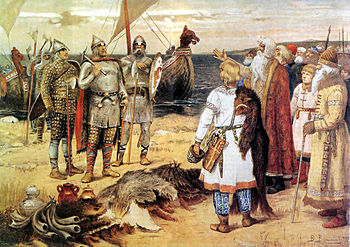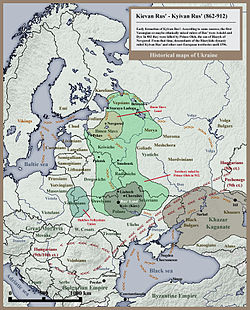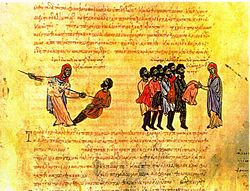
The Invitation of the Varangians by Viktor Vasnetsov: Rurik and his brothers
Sineus and Truvor arrive to the lands of Ilmen Slavs.
Varangians

The Invitation of the Varangians by Viktor Vasnetsov: Rurik and his brothers
Sineus and Truvor arrive to the lands of Ilmen Slavs.
The Varangians or Varyags (Old Norse: Væringjar; Greek: Βάραγγοι, Βαριάγοι, Varangoi, Variagoi; Russian and Ukrainian: Варяги, Varyagi / Varyahy; Belarusian: Варагі, Varahi), sometimes referred to as Variagians, were people from the Baltic region, most often associated with Vikings, who from the 9th to 11th centuries ventured eastwards and southwards along the rivers of Eastern Europe, through what is now Russia, Belarus and Ukraine, connecting Scandinavia with Jerusalem, Constantinople and Baghdad.
According to the Primary Chronicle of Rus, compiled in about 1113 AD, a group of Varangians called the Rus' people (according to one hypothesis, a group of Swedish Vikings who relocated from Uppland, Sweden, to Northeastern Europe) organized an early politity centered around Ladoga and Novgorod under their leader Rurik, laying the foundation for the Rurik dynasty. Under the leadership of Oleg of Novgorod, a relative of Rurik, the Varangians expanded southwards by capturing Kiev, founding the medieval state of Rus'
Engaging in trade, piracy and mercenary activities, Varangians roamed the river systems and portages of Gardariki, as Rus' lands were known in Norse sagas. They controlled the Volga trade route connecting Baltic to the Caspian Sea, and the Dnieper trade route leading to the Black Sea and Constantinople. Those were the critically important trade links at that time, connecting the Dark Age Europe with wealthy and developed Arab Caliphates and Byzantine Empire; via those routes most of the silver coinage came from the East to the West.
Attracted by the riches of Constantinople, Rus' Varangians initiated a number of Rus'-Byzantine Wars, some of which resulted in advantageous trade treaties. At least from the early 10th century many Varangians served as mercenaries in the Byzantine Army, comprising the so-called Varangian Guard. Eventually most of them, both in Byzantium and in Eastern Europe, were converted from paganism into Orthodox Christianity, culminating in the 988 Christianization of Kievan Rus'.
The descendants of Rurik were the ruling dynasty of Rus (after 862), the successor principalities of Galicia-Volhynia (after 1199), Chernigov, Vladimir-Suzdal, Grand Duchy of Moscow, and the founders of the Tsardom of Russia. Coinciding with the general decline of the Viking Age, the influx of Norsemen to Rus' stopped, and Varangians were eventually assimilated by East Slavs by the late 11th century.
The event of Rurik's arrival in 862 to Northern Russia on request of its peoples, known as the Invitation of the Varangians (Russian: Призвание Варягов), remains to be regarded the traditional starting point of Russian history.
Varangian Rus'
Having settled Aldeigja (Ladoga) in the 750s, Scandinavian colonists were probably an element in the early ethnogenesis of the Rus' people, and likely played a role in the formation of the Rus' Khaganate. The Varangians (Varyags, in Old East Slavic) are first mentioned by the Primary Chronicle as having exacted tribute from the Slavic and Finnic tribes in 859. It was the time of rapid expansion of the Vikings in Northern Europe; England began to pay Danegeld in 859, and the Curonians of Grobin faced an invasion by the Swedes at about the same date.
Due largely to geographic considerations, it is often argued that most of the Varangians who traveled and settled in the eastern Baltic, Russia and lands to the south came from the area of modern Sweden.
According to the Primary Chronicle, in 862, the Finnic and Slavic tribes rebelled against the Varangian Rus, driving them overseas back to Scandinavia, but soon started to conflict with each other. The disorder prompted the tribes to invite back the Varangian Rus "to come and rule them" and bring peace to the region. Led by Rurik and his brothers Truvor and Sineus, the invited Varangians (called Rus') settled around the town of Holmgård (Novgorod).
In the 9th century, the Rus' operated the Volga trade route, which connected Northern Russia (Gardariki) with the Middle East (Serkland). As the Volga route declined by the end of the century, the trade route from the Varangians to the Greeks rapidly overtook it in popularity. Apart from Ladoga and Novgorod, Gnezdovo and Gotland were major centres for Varangian trade.
The Primary Chronicle twice names Rus' among the other Varangian peoples, including Swedes, Normans, Angles, Gutes (Normans was an Old Russian term for Norwegians, while Angles may be interpreted as Danes); this In some places the chronicle mention Slavs and Rus' as different groups, but other places it mixes them.
Western historians tend to agree with the Primary Chronicle that these Varangians organized the existing Slavic settlements into the political entity of Kievan Rus' in the 880s and gave their name to the land. Many Slavic scholars are opposed to this theory of Germanic influence on the Rus' and have suggested alternative scenarios for this part of Eastern European history because the author of the Primary Chronicle, that is a monk named Nestor, worked in the court for the Varangians.
In contrast to the intense Scandinavian influence in Normandy and the British Isles, Varangian culture did not survive to a great extent in the East. Instead, the Varangian ruling classes of the two powerful city-states of Novgorod and Kiev were thoroughly Slavicised by the end of the 10th century. Old Norse was spoken in one district of Novgorod, however, until the thirteenth century.
Rus' and the Byzantine Empire

Map showing the major Varangian trade routes at
the time of early formation of Kievan Rus'.
The earliest Byzantine record of the Rus' may have been written prior to 842, which speaks of a raid that extended into Paphlagonia. In 839, emperor Theophilus negotiated with the foreigners, whom he called Rhos, to provide a few mercenaries for his army.
It was in 860, from Kiev, that the Rus under Askold and Dir launched their first attack on Constantinople. The result of this initial attack is disputed, but the Varangians continued their efforts as they regularly sailed down the Dnieper into the Black Sea. The Rus' raids into the Caspian Sea were recorded by Arab authors in the 870s and in 910, 912, 913, 943, and later. Although the Rus had predominantly peaceful trading relations with the Byzantines, the rulers of Kiev launched the relatively successful naval expedition of 907 and the abortive campaign of 941 against Constantinople, as well as Sviatoslav I's large-scale invasion of the Balkans in 968–971.
These raids were successful in the sense of forcing the Byzantines to re-arrange their trading arrangements; militarily, the Varangians were usually defeated by the superior Byzantine forces, especially in the sea and due to the Byzantines' use of Greek fire. Many atrocities were reported by (not wholly impartial) Greek historians during such raids: the Rus' were said to have crucified their victims and to have driven nails into their heads.
Varangian Guard

Varangian Guardsmen, an illumination from the Skylitzis Chronicle.
The Varangian Guard (Greek: Τάγμα των Βαράγγων, Tágma tōn Varángōn) were a part of the Byzantine Army and personal bodyguards of the Byzantine Emperors from the 9th to the 14th centuries. Initially, the guard was composed of Varangians who came from in the Kievan Rus.
The guard was first formed under Emperor Basil II after 988, following the Christianization of Kievan Rus' and union with Vladimir I of Kiev, who sent 6,000 men to Basil as a part of military assistance agreement. Basil's distrust of the native Byzantine guardsmen, whose loyalties often shifted with fatal consequences, as well as the proven loyalty of the Varangians, many of whom served in Byzantium even before, led the Emperor to employ them as his personal guard.
Over the years, new recruits from Sweden, Denmark, and Norway kept a predominantly Scandinavian cast to the organization until the late 11th century. So many Scandinavians left to enlist in the guard that a medieval Swedish law from Västergötland stated that no one could inherit while staying in "Greece"—the then Scandinavian term or the Byzantine Empire. In the eleventh century, there were also two other European courts that recruited Scandinavians: Kievan Rus' c. 980–1060 and London 1018–1066.
Composed primarily of Scandinavians for the first 100 years, the guard began to see increased inclusion of Anglo-Saxons after the successful invasion of England by the Normans. By the time of the Emperor Alexios Komnenos in the late 11th century, the Byzantine Varangian Guard was largely recruited from Anglo-Saxons and "others who had suffered at the hands of the Vikings and their cousins the Normans". The Anglo-Saxons and other Germanic peoples shared with the Vikings a tradition of faithful (to death if necessary) oath-bound service, and after the Norman Conquest of England there were many fighting men who had lost their lands and former masters and looked for a living elsewhere.
The Varangian Guard not only provided security for the Byzantine Emperors, but participated in many wars involving Byzantium and often played a crucial role, since they were usually used at the critical moments of a battle. By the late 13th century Varangians were mostly ethnically assimilated by Byzantines, though the guard operated until at least mid-14th century and in 1400 there were still some people identifying themselves as "Varangians" in Constantinople.